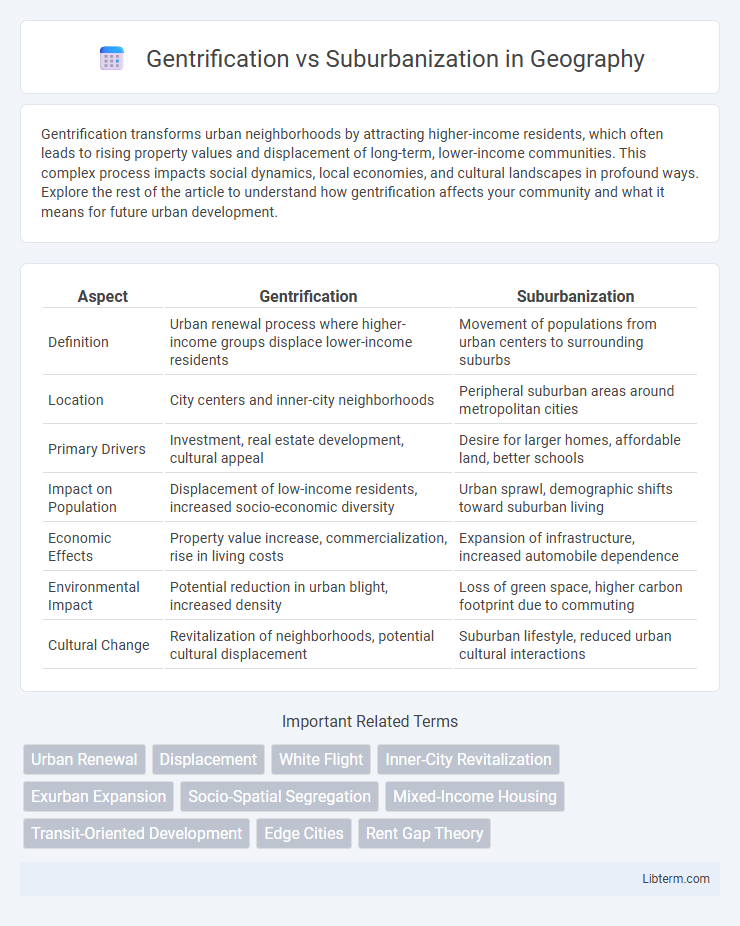Gentrification transforms urban neighborhoods by attracting higher-income residents, which often leads to rising property values and displacement of long-term, lower-income communities. This complex process impacts social dynamics, local economies, and cultural landscapes in profound ways. Explore the rest of the article to understand how gentrification affects your community and what it means for future urban development.
Table of Comparison
| Aspect | Gentrification | Suburbanization |
|---|---|---|
| Definition | Urban renewal process where higher-income groups displace lower-income residents | Movement of populations from urban centers to surrounding suburbs |
| Location | City centers and inner-city neighborhoods | Peripheral suburban areas around metropolitan cities |
| Primary Drivers | Investment, real estate development, cultural appeal | Desire for larger homes, affordable land, better schools |
| Impact on Population | Displacement of low-income residents, increased socio-economic diversity | Urban sprawl, demographic shifts toward suburban living |
| Economic Effects | Property value increase, commercialization, rise in living costs | Expansion of infrastructure, increased automobile dependence |
| Environmental Impact | Potential reduction in urban blight, increased density | Loss of green space, higher carbon footprint due to commuting |
| Cultural Change | Revitalization of neighborhoods, potential cultural displacement | Suburban lifestyle, reduced urban cultural interactions |
Understanding Gentrification: Definition and Key Features
Gentrification refers to the process where urban neighborhoods undergo transformation through an influx of wealthier residents, leading to increased property values and displacement of lower-income communities. Key features include renovation of housing, shifts in demographic composition, and changes in local businesses and culture. This urban renewal often contrasts with suburbanization, which involves the movement of populations from urban centers to surrounding suburbs, influencing city dynamics and housing markets differently.
What is Suburbanization? Origins and Characteristics
Suburbanization refers to the demographic shift from urban centers to surrounding suburban areas, originating in the early 20th century with the rise of automobile accessibility and post-World War II economic prosperity. Characterized by lower population density, single-family homes, and increased reliance on personal vehicles, suburbanization reshaped residential patterns and contributed to urban sprawl. This process often reflects socioeconomic factors including the pursuit of affordable housing, better living conditions, and perceived safety outside city cores.
Historical Context: Urban Shifts and Socioeconomic Trends
Gentrification emerged prominently in the late 20th century as urban centers experienced reinvestment and demographic shifts, often displacing long-term, lower-income residents. Suburbanization began earlier, accelerating post-World War II, driven by affordable housing, automobile accessibility, and federal policies promoting homeownership in suburban areas. These opposing trends reflect broader socioeconomic patterns: gentrification concentrates wealth and cultural capital in city cores, while suburbanization disperses populations and economic activities to peripheral zones.
Comparing Demographic Changes: Urban vs. Suburban Migration
Gentrification typically attracts younger, higher-income professionals and often results in the displacement of lower-income, long-term urban residents, altering the demographic makeup of cities. Suburbanization usually involves families seeking larger homes and better schools, contributing to an increase in suburban population density and socioeconomic diversity. Migration patterns reveal a shift where urban centers experience an influx of affluent, often younger populations, while suburbs expand with middle-class families, reshaping both urban and suburban demographic landscapes.
The Economic Impact of Gentrification vs. Suburbanization
Gentrification typically boosts local economies by increasing property values and attracting higher-income residents, leading to greater tax revenues and revitalized businesses, but often displaces low-income communities. Suburbanization drives economic growth through expanded housing and commercial developments, creating jobs and increasing consumer markets in outer urban areas while potentially draining resources from city centers. Both processes reshape regional economies differently, with gentrification concentrating wealth in urban cores and suburbanization spreading economic activity outward.
Housing Markets: Affordability and Availability
Gentrification drives up housing prices and reduces availability in urban neighborhoods by attracting higher-income residents and investors, often displacing lower-income families. Suburbanization expands housing supply in outer areas, typically offering more affordable options but can lead to longer commutes and increased infrastructure demands. Both processes significantly impact housing market dynamics, influencing affordability and accessibility for diverse populations.
Cultural Transformation and Community Displacement
Gentrification drives cultural transformation by attracting affluent residents who often alter the neighborhood's original identity, leading to the displacement of long-standing communities due to rising housing costs and changing social dynamics. Suburbanization shifts populations outward, fostering new cultural landscapes but also fragmenting established urban communities, resulting in diminished access to traditional urban resources for displaced residents. Both processes reshape social fabrics and spatial organization, intensifying disparities in cultural representation and community cohesion.
Infrastructure and Urban Planning Differences
Gentrification often involves the revitalization of existing urban infrastructure, emphasizing walkability, public transit access, and mixed-use development to foster dense, vibrant communities. In contrast, suburbanization prioritizes expansive road networks, single-family homes, and car-dependent layouts with less emphasis on public transport or pedestrian-friendly design. Urban planning in gentrified areas typically focuses on adaptive reuse and sustainable growth within established city grids, whereas suburban planning favors new construction with segregated land uses and infrastructure catering to automobile travel.
Social Equity: Winners and Losers in Each Process
Gentrification often displaces long-term, lower-income residents as rising property values and rents favor wealthier newcomers, intensifying social inequities in urban neighborhoods. Suburbanization shifts economic resources and opportunities to outlying areas, frequently benefiting middle- and upper-income families while exacerbating racial and economic segregation and access disparities. Both processes create distinct social winners and losers, with gentrification concentrating investment in central cities but marginalizing vulnerable populations, and suburbanization privileging those with mobility and resources at the expense of inner-city equity.
Future Trends: Urbanization, Policy, and Sustainable Development
Future trends in urbanization emphasize a balance between gentrification and suburbanization, driven by smart urban policies promoting inclusivity and affordable housing. Sustainable development frameworks are increasingly integrated to reduce environmental impact and enhance community resilience in expanding metropolitan areas. Innovations in green infrastructure and transit-oriented development will shape cities' ability to accommodate population growth while preserving socio-economic diversity.
Gentrification Infographic

 libterm.com
libterm.com